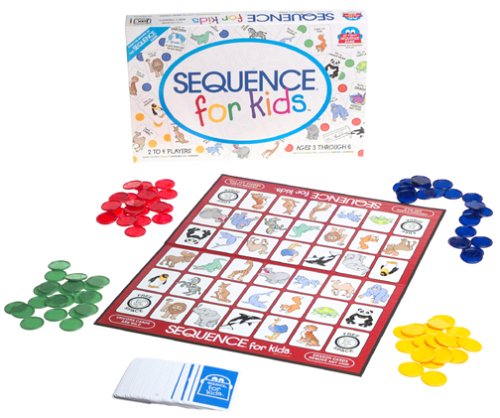
With the holidays upon us it seems like every geek blogger I read has been recommending family-friendly board games. MacSparky sent me to Fanny Pack Mafia, Marco says Power Grid is really good, and Kottke is sending me to Gautam Narula to improve my chess game. This is all well and good, but these games are a bit much for my 2.5 and 5 year old kids. Maybe that’s why our favorite game hasn’t been on any of these lists.
The rules for Sequence for Kids
are simple. The game starts with each player getting three cards and a pile of their own colored chips. The cards have animals on them as does the board which is a 6x7 square grid. A turn consists of playing a card and putting one of your chips on a square that has the same animal that was on the card. Players replenish their hand by picking another card from the deck at the end of their turn. The goal is to get four chips in a row. There are two “magical” animals: The Unicorn card lets a player put their chip on any square while the Dragon card lets a player remove any chip from the board.
Many games for little kids are designed simply to teach rule following and maybe some hand-eye coordination as the player spins a spinner or picks a card and moves their token along a track. Chutes and Ladders and Candyland are the canonical examples of a genre that rots adult brains. Sequence includes enough strategy that kids are challenged, and enough randomness that they have a chance to win against adults.
The set of skills kids can learn (or practice) while playing is surprisingly rich:
- Forward thinking: Players need to make sequences of two before they can make three and then four to win. They need to recognize when their opponent is about to win, and then block them if possible.
- Patience: Players should save their special cards for when they need them for defense or offense.
- Reasoning about uncertainty: I wonder if my opponent has a Lion in their hand and could win next turn? I wonder if I could pick a Lion from the deck for my next turn? Maybe two Lions have already been played and none are left!
- Pattern recognition: Where are my winning opportunities? Four in a row wins whether it is across, down or diagonal.
- Creativity: R thinks the magic animals are the best part of the game and we often make up our own rules to create more. Sometimes the Kangaroo card lets you put down a chip on a Kangaroo and another square next to it. Sometimes the Shark can eat another animal and let you put your own chip in its place. The possibilities are endless.
- Reading: The game even promotes reading in a subtle way. The cards have pictures of the animals for non-readers, words for the animal (e.g. “Penguin”) for learning readers, and even a fun name for the animal (e.g., “Percy”) for actual readers.
Perhaps the best part of the game is that it’s easy to modify the game for players of any age. We often play with cards face up. This makes reasoning about your opponent’s next move a little clearer and has two other big advantages: Little uncoordinated hands don’t have to try to hold three cards at once, and it’s a lot easier to teach strategy when you can see what cards your kid is holding. I’ve also played a fairly rule-free version of the game with one and two year-olds where we just deal out cards and place chips on the board. These kids love the animals and the bright colors of the chips and even like matching the animals to the squares on the board.
Sequence for Kids really is fun for the whole family!